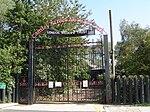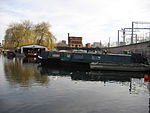St Pancras Old Church
Anglo-Catholic church buildings in the London Borough of CamdenAnglo-Catholic churches in England receiving AEOChurch of England church buildings in the London Borough of CamdenDiocese of LondonGrade II* listed churches in London ... and 3 more
Harv and Sfn no-target errorsSt Pancras, LondonUse British English from February 2015

St Pancras Old Church is a Church of England parish church in Somers Town, Central London. It is dedicated to the Roman martyr Saint Pancras, and is believed by many to be one of the oldest sites of Christian worship in England. The church is situated on Pancras Road in the London Borough of Camden, with the surrounding area and its international railway station taking its name. St Pancras Old Church, which was largely rebuilt in the Victorian era, should not be confused with St Pancras New Church (1819–1822) about 860 metres (940 yd) away, on Euston Road.
Excerpt from the Wikipedia article St Pancras Old Church (License: CC BY-SA 3.0, Authors, Images).St Pancras Old Church
Pancras Road, London Somers Town
Geographical coordinates (GPS) Address Website External links Nearby Places Show on map
Geographical coordinates (GPS)
| Latitude | Longitude |
|---|---|
| N 51.534897222222 ° | E -0.13018888888889 ° |
Address
St Pancras Old Church
Pancras Road
NW1 1UL London, Somers Town
England, United Kingdom
Open on Google Maps








